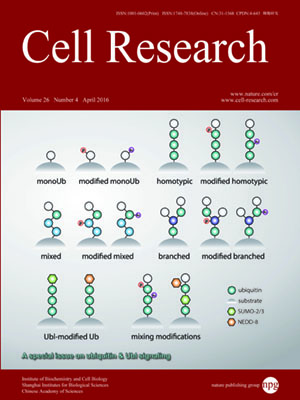
Volume 26, No 4, Apr 2016
ISSN: 1001-0602
EISSN: 1748-7838 2018
impact factor 17.848*
(Clarivate Analytics, 2019)
Volume 26 Issue 4, April 2016: 389-390
EDITORIAL
Recent progress in ubiquitin and ubiquitin-like protein (Ubl) signaling
Ronggui Hu1,2,3 and Mark Hochstrasser4,5
1Key Laboratory of Systems Biology, University of Chinese Academy of Sciences; Institute of Biochemistry and Cell Biology, Shanghai Institutes for Biological Sciences, Chinese Academy of Sciences, 320 Yue-yang Road, Shanghai 200031, China
2CAS Center for Excellence in Molecular and Cell Science, University of Chinese Academy of Sciences; Institute of Biochemistry and Cell Biology, Shanghai Institutes for Biological Sciences, Chinese Academy of Sciences, 320 Yue-yang Road, Shanghai 200031, China
3Innovation Center for Cell Signaling Network, University of Chinese Academy of Sciences; Institute of Biochemistry and Cell Biology, Shanghai Institutes for Biological Sciences, Chinese Academy of Sciences, 320 Yue-yang Road, Shanghai 200031, China
4Department of Molecular Biophysics & Biochemistry, Yale University, 266 Whitney Avenue, New Haven, CT 06520, USA
5Department of Molecular, Cellular, & Developmental Biology, Yale University, 266 Whitney Avenue, New Haven, CT 06520, USA
Correspondence: Ronggui Hu, E-mail: coryhu@sibcb.ac.cn; Mark Hochstrasser(mark.hochstrasser@yale.edu)
Ubiquitin (Ub), a 76-residue polypeptide that is present in all eukaryotes, can be covalently conjugated to other proteins or other Ub molecules. Such ubiquitination (or ubiquitylation) reactions involve a cascade of reactions catalyzed by E1 (ubiquitin-activating enzyme), E2 (ubiquitin-conjugating enzyme) and E3 (ubiquitin ligase) proteins. The human Ub system encompasses ~40 E2s and ~700 E3s that specifically recognize and conjugate Ub to their substrates, including other Ub molecules. Protein ubiquitination is reversed by deubiquitinating enzymes (DUBs), which number close to 100 in humans. Ub can be ubiquitinated on any of its seven lysine residues or its N-terminus, leading to the formation of polyubiquitin chains in various configurations, each thought to create distinct signals recognized by specific Ub receptors. It has become clear that the functional consequences of protein ubiquitination can be far more diverse than simply tagging the protein for proteolytic elimination, although this is a frequent outcome. The term “ubiquitin signaling” collectively refers to the many ways that ubiquitination and deubiquitination reactions impact the function, localization, trafficking, or stability of a protein in the context of cellular regulation.
10.1038/cr.2016.43
FULL TEXT | PDF
Browse 2221


